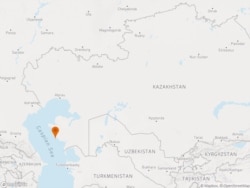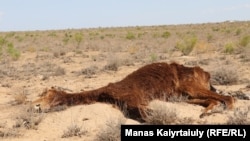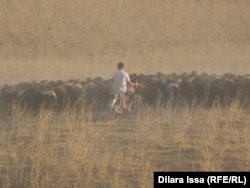Most of Central Asia is experiencing an extreme drought this year, and the people there know that all too well.
They swelter in scorching heat and record temperatures amid a severe lack of rain.
But that does not stop them from looking for someone to blame -- and often there are people who should accept some responsibility for mismanagement.
Out On The Farm
The first to recognize the signs of a severe drought are the farmers and herders.
In Kazakhstan's western Mangistau Province, civic activist Zhanibek Kozhyk told RFE/RL's Kazakh Service, known locally as Azattyq, that the old people in the province say they have never seen anything like the current drought.
Kozhyk said it was obvious in early spring that a severe drought was coming, and he blamed officials for failing to heed the warning signs.
Mangistau is mostly desert, but there are areas where herding is possible so the losses in the province are often counted in sheep, cows, and horses, thousands of which have already died -- though no one is really sure how many.

There is little grass for herds to graze upon and the price of hay and grain for animal feed has skyrocketed in many parts of Kazakhstan.
There were reports in June that some herders were resorting to feeding their horses cardboard mixed with table scraps.
Kozhyk said people were bringing cardboard from the Caspian coastal city of Aqtau to feed their animals but that now, "There is a shortage of cardboard."
The Kazakh government was late in fully appreciating the magnitude of the situation, but measures have been taken to bring in hay from other parts of Kazakhstan and make it available at reasonable prices.
On July 26, the Kazakh Agriculture Ministry also imposed a six-month ban on exports of fodder and grain for animal food so that supplies could be redirected internally.
Thousands of kilometers to the southeast, in Kyrgyzstan's northern Chui Province, the farmers were among the first to appreciate the depth of the drought.
Crops sprouted but then began to wither due to insufficient water supplies.
Kyrgyz officials stated the obvious -- that there simply was not enough water -- but they also pointed to a Soviet-era canal and irrigation system that was badly in need of repair and simply insufficient to meet modern-day needs.
Kyrgyz Deputy Agricultural Minister Nurlan Sheripov pointed out in mid-June that the Soviet irrigation system in Chui was built for state farms that grew crops that did not require frequent watering.
"Today, private farmers grow corn…berries and melons and other more water-intensive crops in the fields, constantly requiring water," he said.
Since the authorities seemed incapable of doing anything immediately, some farmers in Chui took matters into their own hands and took more than their share of water from canals or diverted water to their fields, usually at night, angering those whose fields were suddenly left dry.
Authorities eventually had to close off the small reservoirs that feed the canals at night and put guards around them.
Farmers in Chui then blocked the main road between Osh and Bishkek, demanding authorities resolve their water problems.
Local officials promised to repair existing canals and water-storage facilities, build new ones, and dig new wells in the province.
In Uzbekistan's eastern Namangan Province, an argument over water between a farmer in the Davlatabad district and another from the Turakurgan district ended with a fight that left the latter farmer with a deadly head injury.
A few hundred kilometers to the west, farmers in the Angor district of Surhandarya Province are in a dispute with a local cluster farm.
The private farmers in the village of Navshahar say the cluster farm is getting most of the water and blame local officials for the unfair distribution of water.
RFE/RL's Uzbek Service, known locally as Ozodlik, reported that the conflict between private farmers and those from the state cluster farm started in early July and a court is hearing the case. In the meantime, almost daily arguments break out between the two groups near the canal that is supposed to supply both of them with water, and police have been called several times to prevent violence from breaking out.
Ozodlik reported that such conflicts between farmers are common in many regions of Uzbekistan.
Life In The City
Farmers and herders might have been the first to see the water shortage coming, but it is now clear to people in the cities what the drought means for them.
RFE/RL's Tajik Service, known locally as Ozodi, reported that many residents of Kulob, Tajikistan's third-largest city, are having problems with water in their homes and are forced to bring plastic bottles and buckets to public water taps and haul them back to their apartments.
Talab Ibrohimov, a resident of Kulob's Shohin neighborhood, told Ozodi: "I am 78 years old, and now I am carrying two plastic buckets [a day]. This is my job, to carry water."
On the night of July 12, about 100 residents of the town of Besagash, outside Kazakhstan's largest city, Almaty, blocked the main road to protest water cuts to their homes.
Similar problems were reported in the city of Oral in northwestern Kazakhstan.
For Turkmenistan, sweltering in the summer heat is normal, but this year temperatures around the country are often hitting 50 degrees Celsius.
In the eastern Lebap Province, the mercury climbed to 55 Celsius (131 Fahrenheit) on July 7.
People in the city of Lebap are buying water from cisterns and bottled water is being brought in from nearby settlements and sold for five manats (about $1.4) per 20 liters, reports RFE/RL's Turkmen Service, known locally as Azatlyk. It's not an exorbitant price, but for families who need the water to wash themselves and their clothes, the costs can mount quickly.
In Kyrgyzstan, where the bulk of the electricity is supplied by hydropower, officials are already warning citizens to prepare for blackouts, partially due to low levels of water in reservoirs and to repairs on the country's main hydropower plant, Toktogul
The water shortage is also leading to an increase in food prices, and with crops wilting and herds being depleted those costs will likely continue to increase into next year.
Carrots are one of the most common ingredients in a variety of Central Asian dishes, but the price for a kilogram of carrots has jumped by some 700 percent in Kazakhstan recently, and the situation is similar in the other four Central Asian countries.
The drought will end one day but the water problems are not going away.
The changing climate contributes to the extreme weather conditions and such hardships are likely to be experienced often in the future.
Central Asia's population -- which was only about 8 million people in the early 1900s and currently numbers about 75 million – will reach about 80 million by 2030 at current growth rates.
Officials across Central Asia are promising to dig more wells as one quick solution to the current water shortages.
In Mangistau, there are people calling for the oil companies to stop drilling for oil and to use their machinery to drill for water.
It's an interesting proposal if for no other reason than to remind everyone what is really the most important liquid in Central Asia.










